Warning: pic heavy, as usual. 
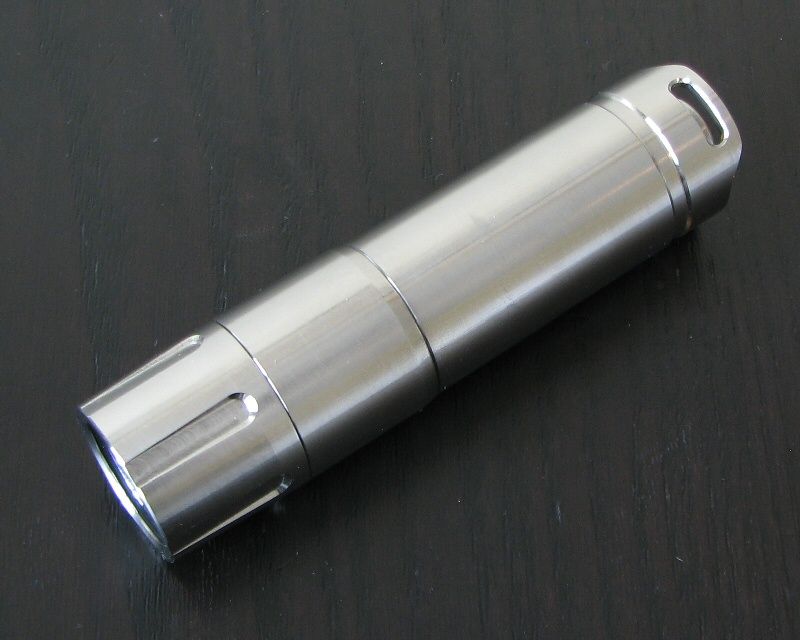
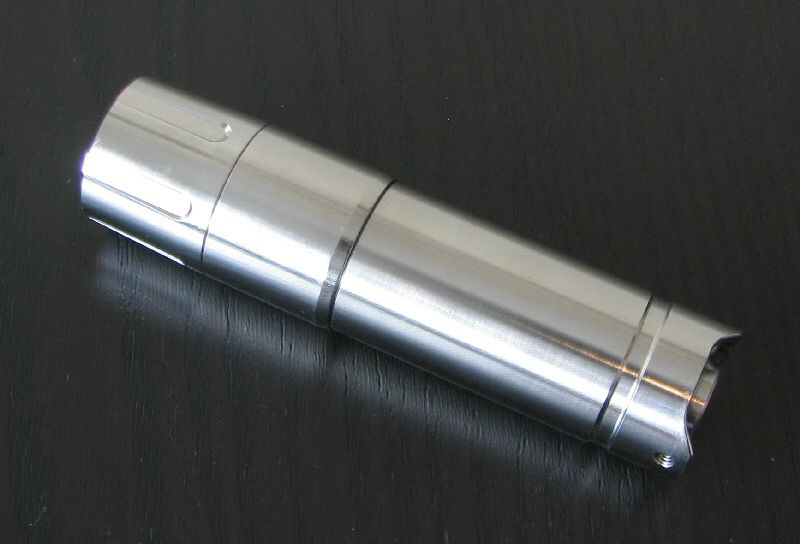

The T20T is the latest model in the newly revised T-series from Thrunite. Like the T01S that I recently reviewed, all now feature reverse clicky switches and XP-G2 emitters (cool or neutral white available). The other distinguishing characteristic is that you typically have the choice of aluminum, stainless steel (S), or titanium construction (T) for each model oo: (although I don't know if all are available yet for the T20).
oo: (although I don't know if all are available yet for the T20).
Note that my review sample was lacking body labels, but I believe these come with the standard black "T20T" labelled on the side of the lights. Let's see how the T20T compares, shall we …
Manufacturer Reported Specifications:
(note: as always, these are simply what the manufacturer provides – scroll down to see my actual testing results).
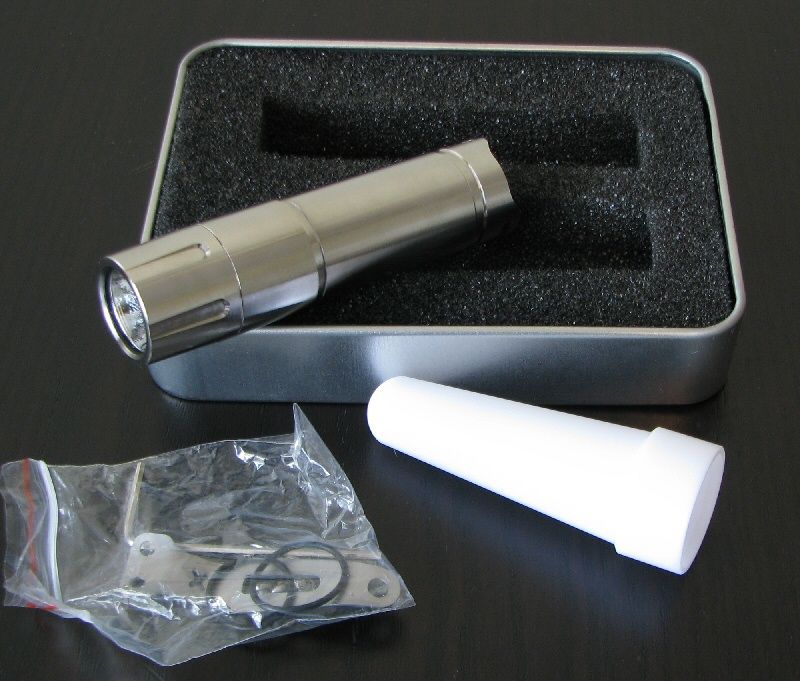
Packaging is the similar to the T10S - stylish, with a light-weight metal case (no clear display window on my sample, though). Inside, in packing foam, is the light, diffuser wand, extra o-ring, pocket clip with screws and mini-Allen key, and manual.

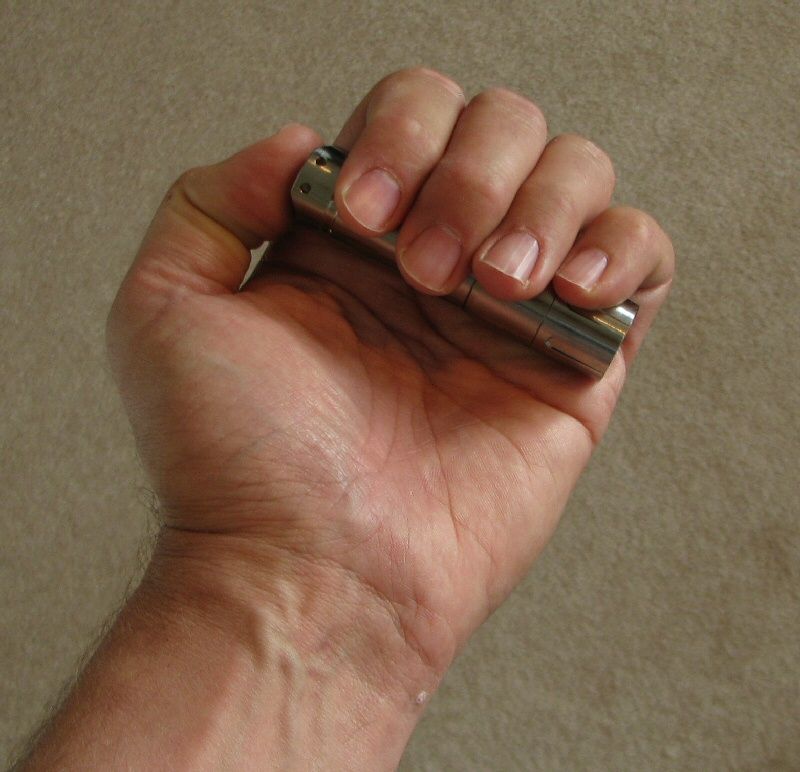
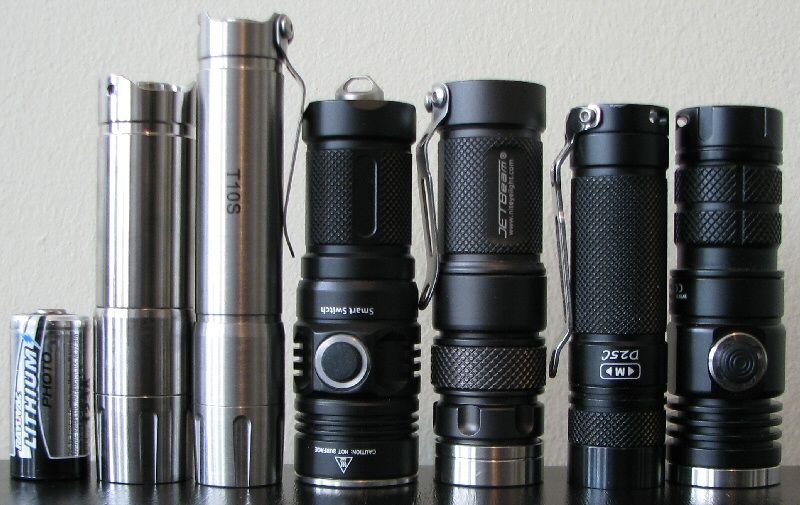
From left to right: Rayovac CR123A; Thrunite T20T, T10S; Sunwayman C10R; JetBeam RRT-01; Eagletac D25C; Skilhunt DS10.
All dimensions directly measured, and given with no batteries installed:
Thrunite T20T: Weight: 43.1g, Length: 80.0mm, Width (bezel): 20.0mm
Thrunite T10S: Weight: 60.9g, Length: 93.7mm, Width (bezel): 17.8mm
ArmyTek C1 XP-G: Weight: 42.6g, Length: 79.8mm , With (bezel): 23.1mm
Lumintop ED11: Weight: 44.1g, Length: 83.7, Width (bezel): 21.8mm
Foursevens QTLC: Weight 36.4g, Length 84.1mm, Width (bezel) 22.1mm
Olight S10: Weight 41.1g, Length: 70.6mm, Width (bezel): 23.0mm
Sunwayman C10R: Weight: 57.3g, Length: 76.2mm (no lanyard plug), 82.3mm (with plug), Width (bezel): 25.6mm, Width (head at widest part): 28.6mm
Eagletac D25C Clicky: Weight: 30g, Length: 76.0mm, Width (bezel): 20.0mm
Jetbeam PC10: Weight: 50.5g, Length: 93.6mm, Width (bezel): 22.6mm
As you can see, the titanium construction of the T20T keeps the weight down compared to the stainless steel T10S. Overall dimensions are still quite reasonable for this class.
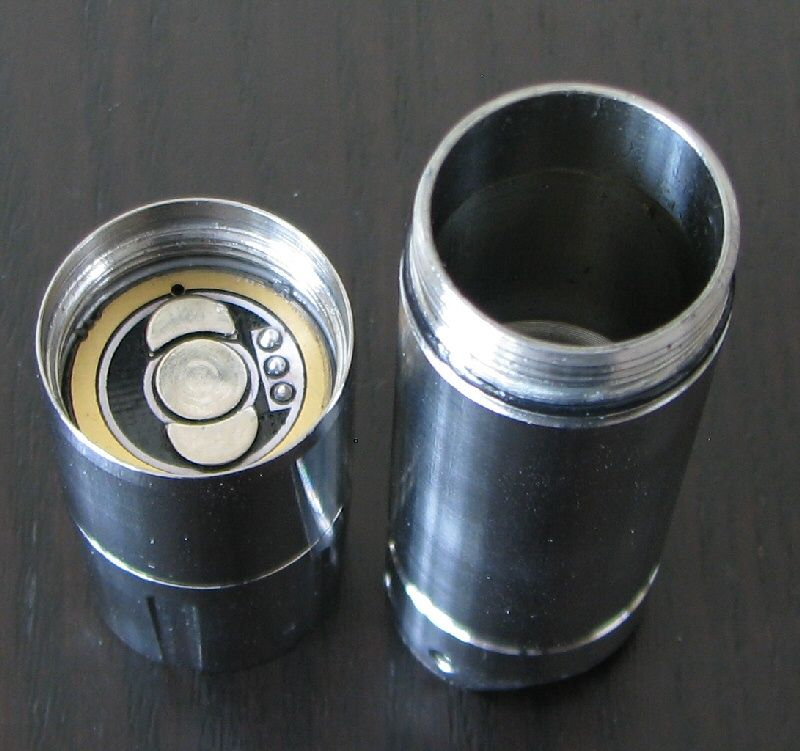
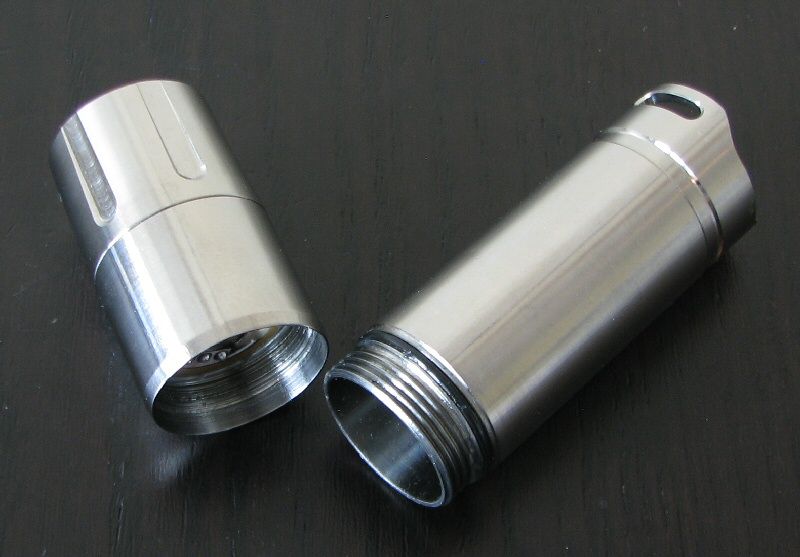
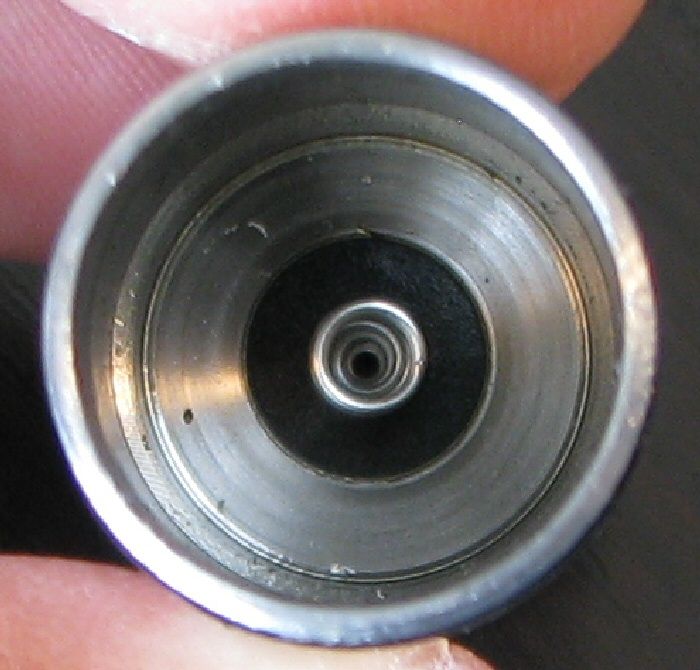
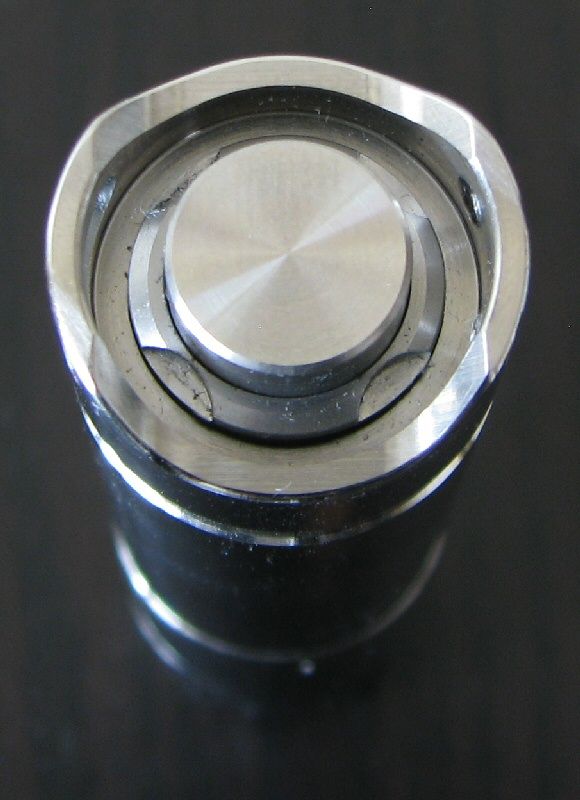
Like T10S, the T20T has a solid build. Titanium is a lighter and stronger metal than stainless steel. Finish on the titanium model is smooth and shiny (compared to brushed finish on the stainless steel model, and black anodizing on the aluminum). Labels are missing on my sample, but shipping versions should have a simple black "T20T" label (i.e., similar to my T10S). As before, there is no knurling to speak of, but there are fluted ridges on the head. This are sufficient to allow you operate the light one-handed (i.e., you can twist the head one-handed).
As always, I recommend you install the included stainless steel pocket clip on these models – not only does it help with grip, bit it serves as an effective anti-roll device (otherwise, there is nothing to stop rolling). The clip is not very large, and fairly lightweight, but seems to work alright as a pocket clip. It reminds me a lot of the clip that comes on the Jetbeam RRT-0 - and is similarly fastened by a pair of hex screws.
While titanium is great for strength and lightness, one of its disadvantages is that you tend to get more "galling" of the screw threads (i.e., titanium doesn't slide over itself as well as other metals). But my T20T sample is surprisingly good in this regard, compared to other titanium lights I've tested. :thumbsup:
This is particularly important on the new T-series lights from Thrunite, as they can still function as a twisty (i.e., contact is only made when the head is fully tight against the body). So as long as you have the tailswitch clicked on, you can mode switch by simply twisting the head (which is feasible single-handed on my T20T).
The physical clicky in the tail is located under a metal boot cover. Switch is the reverse-clicky type (i.e., press and release to turn on/off), however you can change modes by a soft-press. Scroll down to the User Interface section for more info.
There are raised lanyard attachment points at the base of the tail, with cut-outs. As such, the lights can all tailstand stably. However, the actual switch is still somewhat recessed (due to the low-profile switch and boot cover).

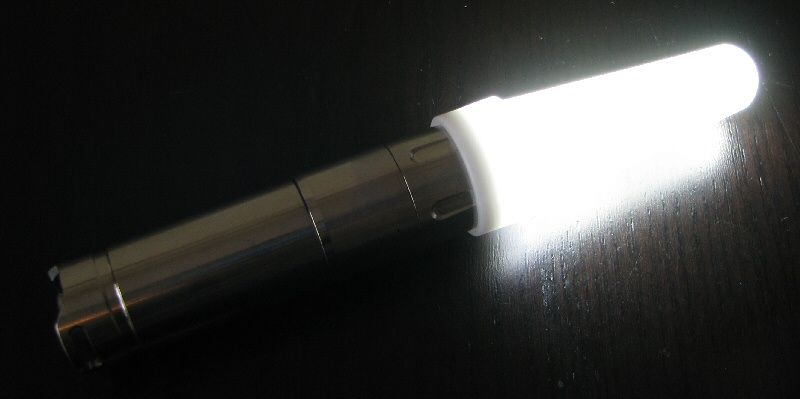
Like the T10S, the T20T comes with a diffuser wand attachment. This fits securely on the light.
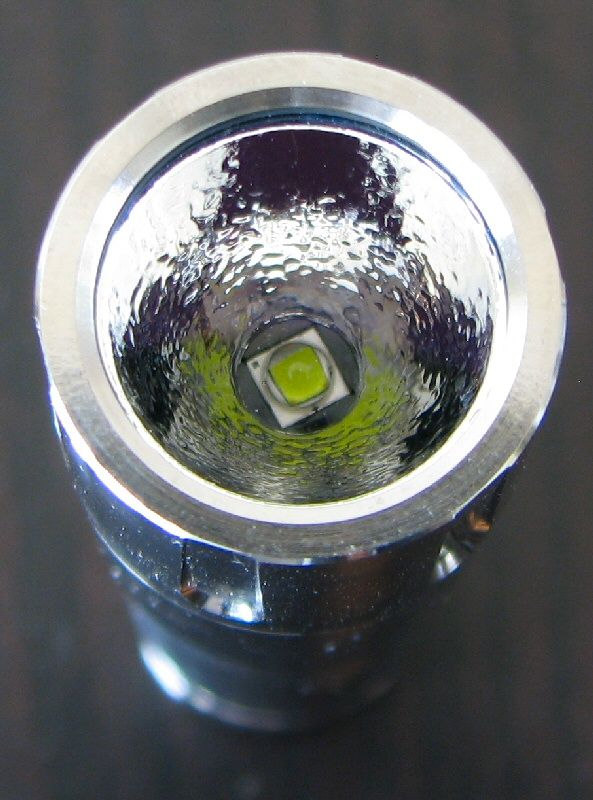
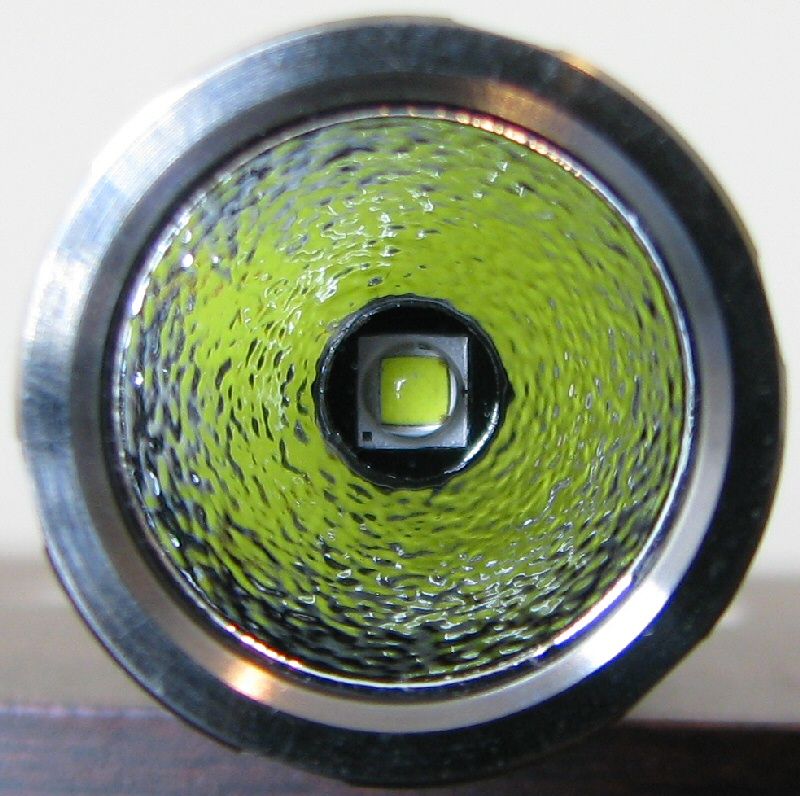
Centering of the XP-G2 cool white emitter was good on my sample (neutral white is also available). The reflector is reasonably deep for the size, and has an orange peel (OP) texturing to help smooth out the beam. Please see my detailed beamshots later in this review.
User Interface
The T20T has the same interface as the T10S.
With the head fully tight, turn the light on or off by the tail switch. Switch is basically a reverse clicky switch, so you need to fully press and release to activate the light (i.e., click and release).
However, you are able to switch modes by either full off/on clicks of the switch, or a partial soft-press and release. Pressure required for the soft press takes a little getting used to, but does work (and is rare on a reverse clicky switch). Mode sequence is Lo > Med > Hi, in repeating sequence.
Thoughtfully, the T10T still works as a twisty-style light – even in titanium form. With the switch clicked in the On position, you can turn the light off/on or change modes by a simple loosen/tighten twist of the head.
There is mode memory, if you wait at least 2 secs after turning the light off before re-activating. Otherwise, you will simply change modes.
There is no strobe or SOS mode on the T20T.
Video:
For information on the light, including the build and user interface, please see my video overview:
As with all my videos, I recommend you have annotations turned on. I commonly update the commentary with additional information or clarifications before publicly releasing the video.
No PWM
There is no sign of PWM at any output level. The T20T is current-controlled.
As mentioned above, there is no strobe or SOS mode on the T20T.
Beamshots:
For white-wall beamshots below, all lights are on Max output on an AW protected 18650 battery. Lights are about ~0.75 meter from a white wall (with the camera ~1.25 meters back from the wall). Automatic white balance on the camera, to minimize tint differences.
1xCR123A
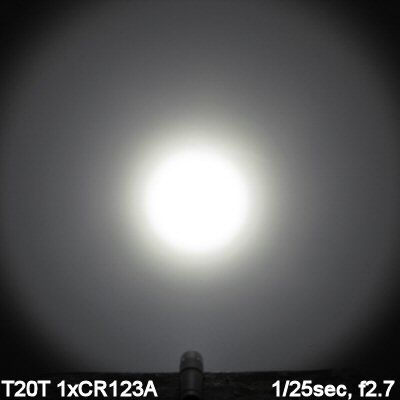
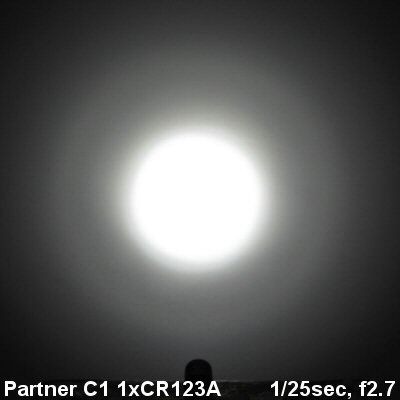
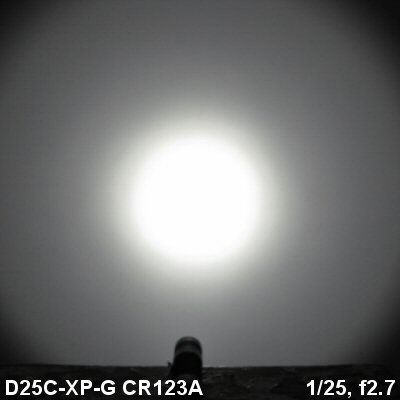
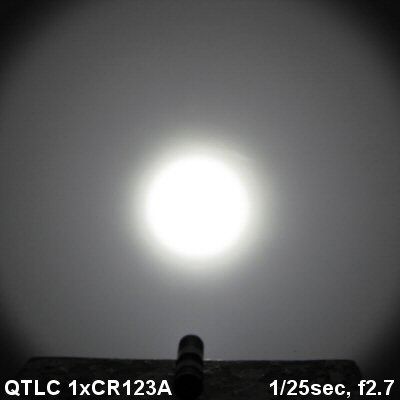
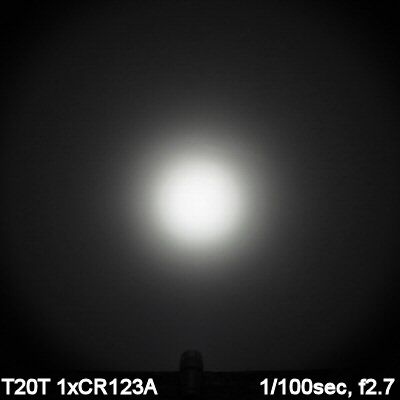
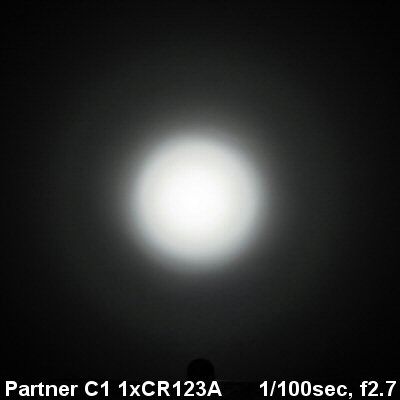
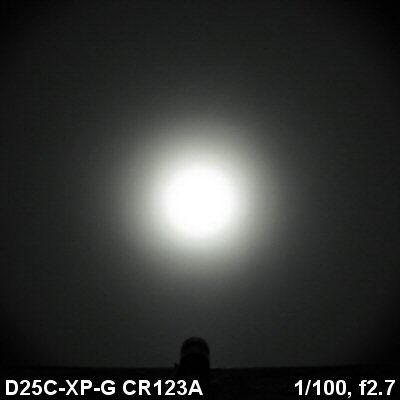
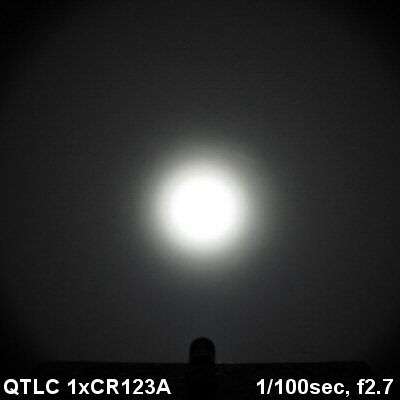
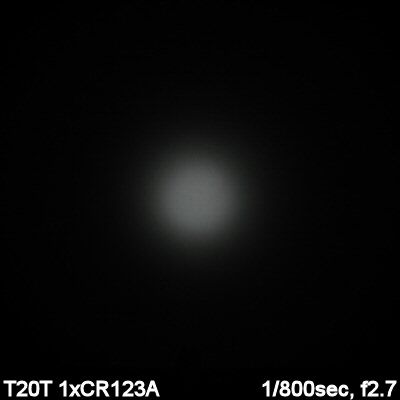
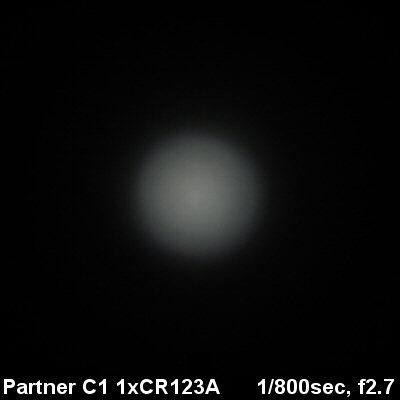
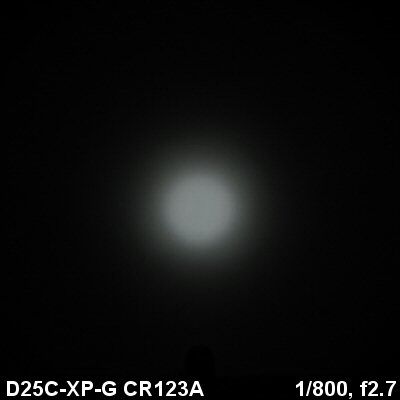
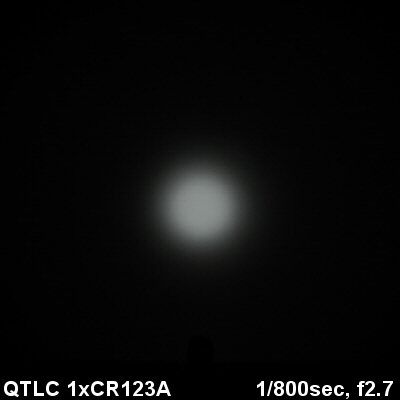
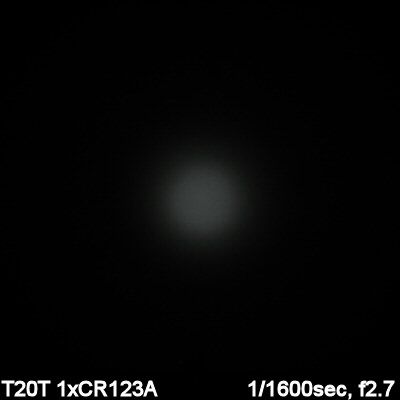
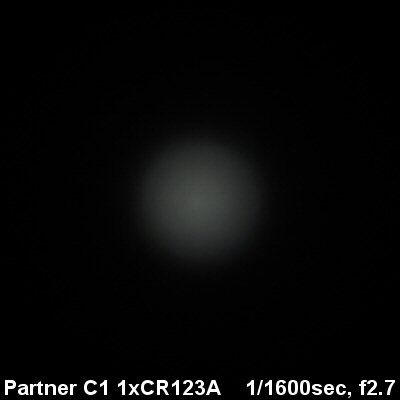
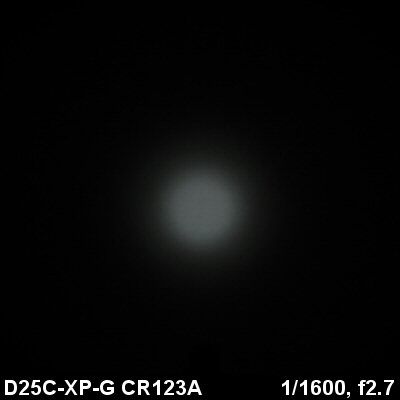
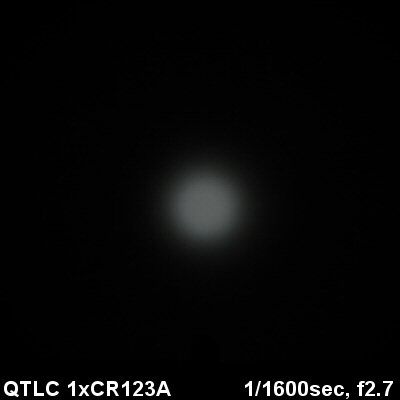
1xRCR
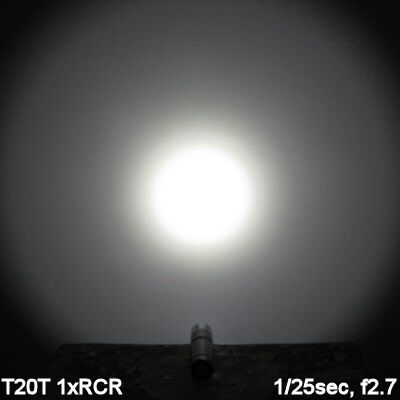
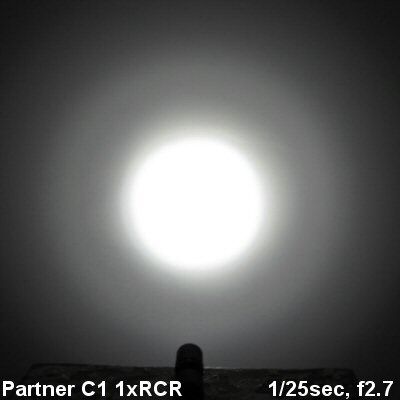
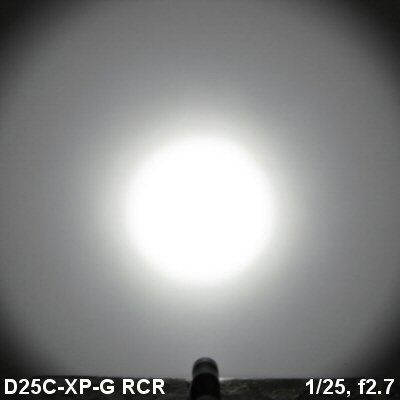
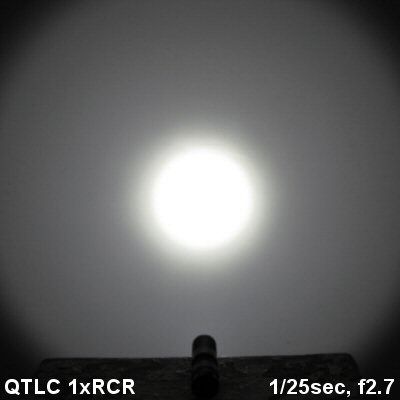
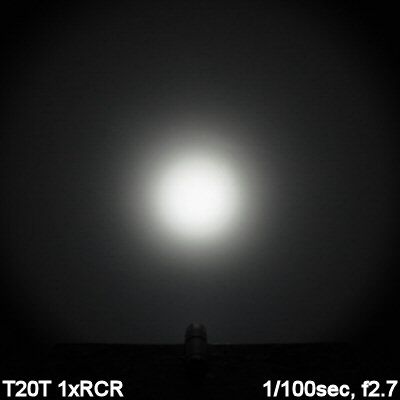
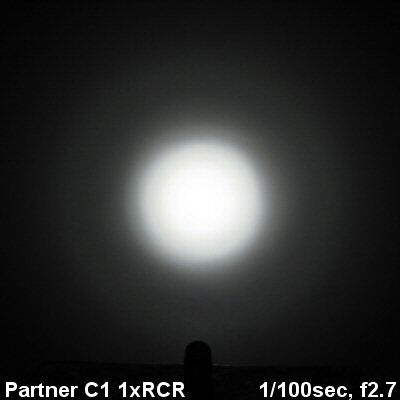
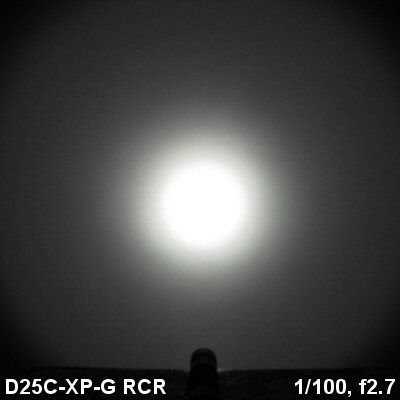
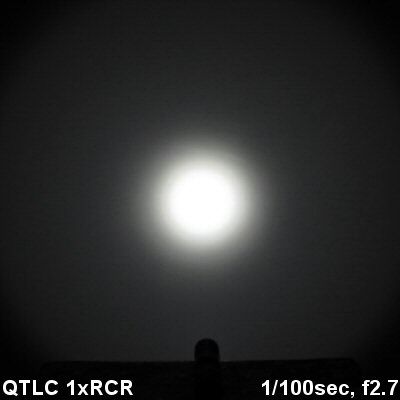
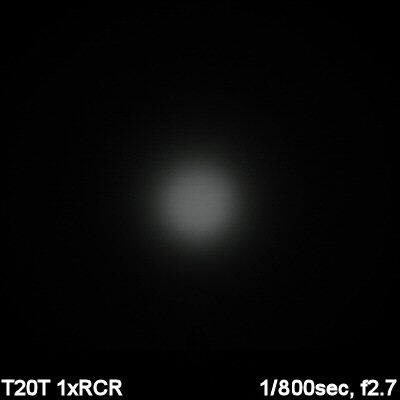
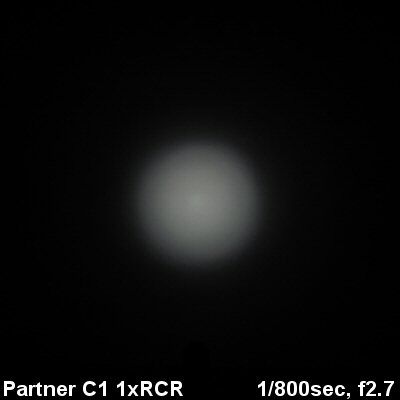
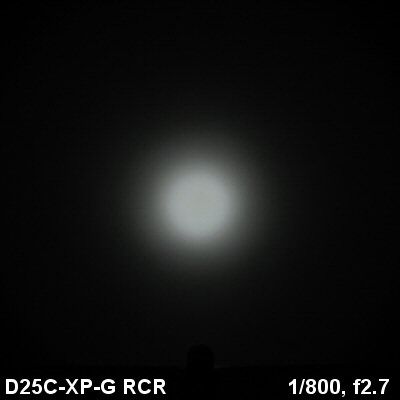
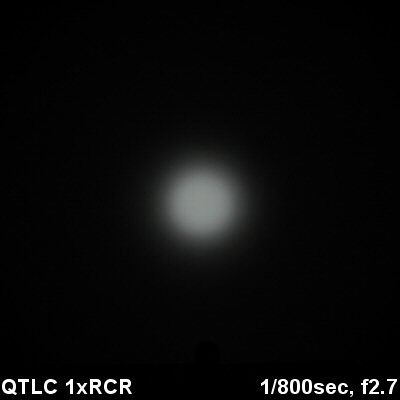
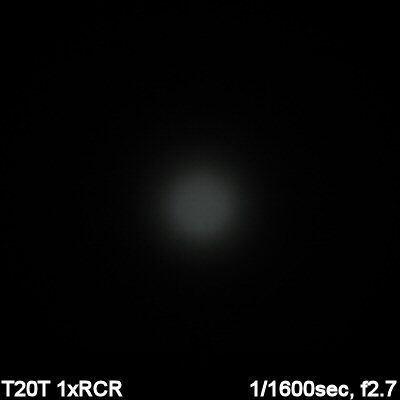
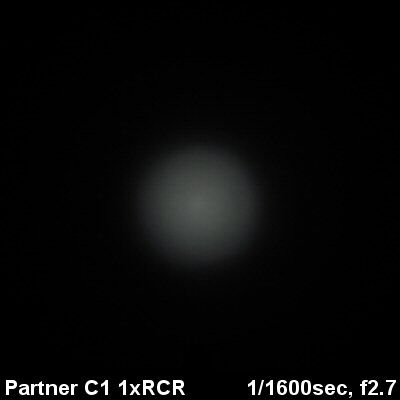
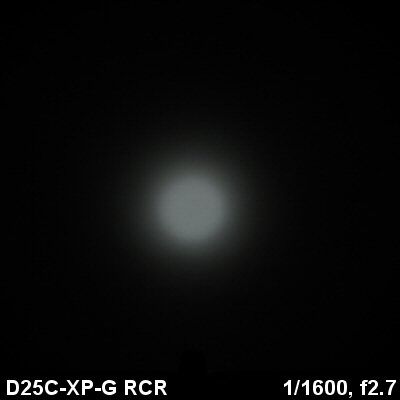
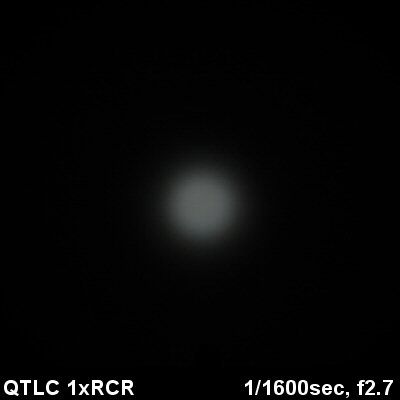
The T20T has a reasonable beam profile for a 1xCR123A/RCR light. It is a bit "throwier" than the T10S, due to the slightly larger head/reflector. Overall output seems comparable on CR123A and RCR for the T20T - which definitely makes it lower than other recent RCR lights. Scroll down to my detailed testing results.
Testing Method:
All my output numbers are relative for my home-made light box setup, as described on my flashlightreviews.ca website. You can directly compare all my relative output values from different reviews - i.e. an output value of "10" in one graph is the same as "10" in another. All runtimes are done under a cooling fan, except for any extended run Lo/Min modes (i.e. >12 hours) which are done without cooling.
I have devised a method for converting my lightbox relative output values (ROV) to estimated Lumens. See my How to convert Selfbuilt's Lightbox values to Lumens thread for more info.
My summary tables are reported in a manner consistent with the ANSI FL-1 standard for flashlight testing. Please see http://www.flashlightreviews.ca/FL1.htm for a discussion, and a description of all the terms used in these tables. Effective July 2012, I have updated all my Peak Intensity/Beam Distance measures with a NIST-certified Extech EA31 lightmeter (orange highlights).
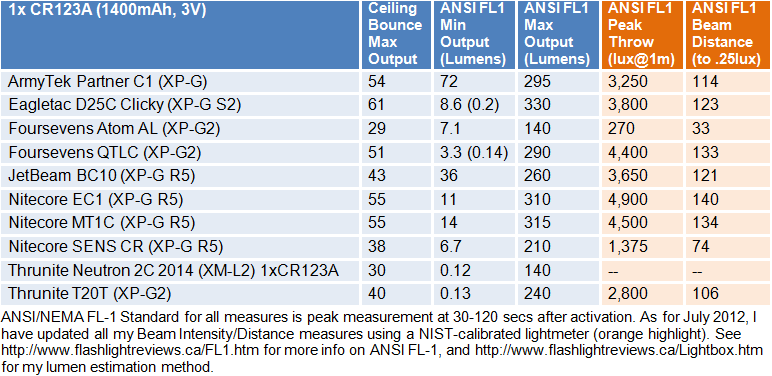
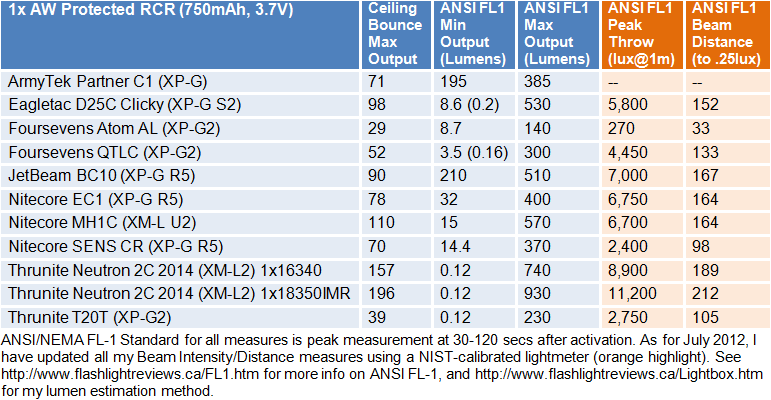
The T20T is not driven as hard on Hi as most other lights I've tested. On CR123A, it is toward the low end of the pack (but not unreasonably so). On RCR however, the T20T definitely trails most of the competition. Peak intensity throw is also reasonable, for the size head. Keep in mind that XP-G/XP-G2 lights show lower output than XM-L/XM-L2 lights on max.
The Lo level is quite low for the class, and is really more of "Moonlight" low level.
Let's see an output breakdown for all levels, relative to the specs:
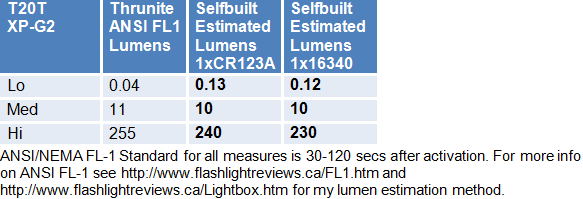
As you can see, my numbers match pretty well to Thrunite's specs. Again, like the T10S, sequence is more of a Moonlight > Lo > Hi spacing.
It is interesting that they have managed to keep the output so consistent between CR123A and RCR.
Runtimes
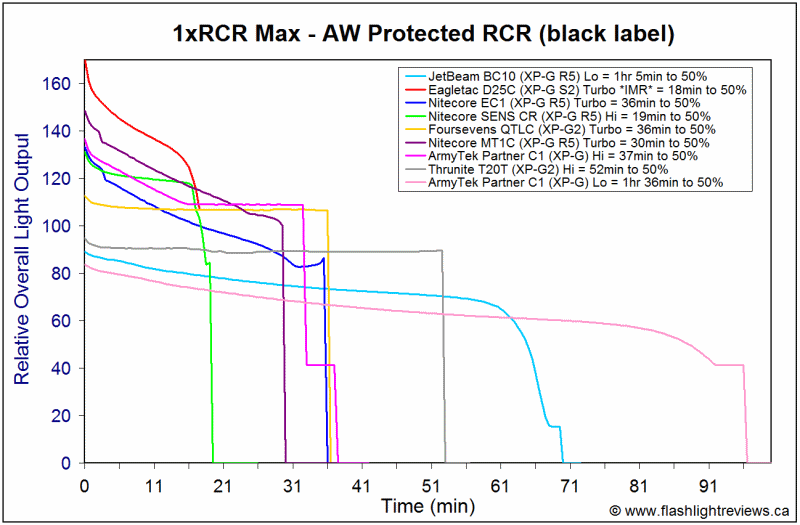
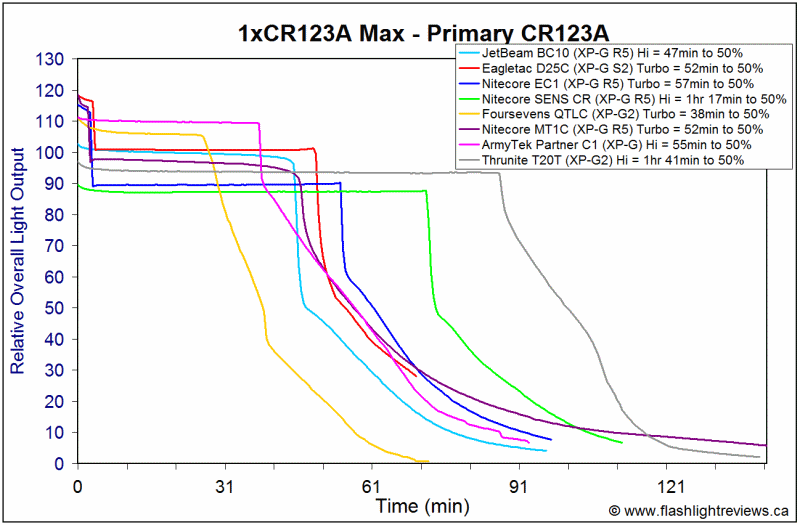
Runtime on Hi is lower than other lights in this XP-G/XP-G2 class. However, overall output/runtime efficiency seems excellent. :thumbsup: The stabilization pattern is also quite flat on both batteries (which is rare for 1xRCR).
Potential Issues
Light will roll easily, unless you install the pocket clip.
Titanium lights can suffer from "galling" on the screw threads, but my T20T is surprisingly smooth (i.e., comparable to my stainless steel T10S).
There is no real "Med" mode on the T20T.
Pressure required on the switch to "soft-press" through output modes takes some getting used to. However, this is still an improvement over most reverse-clicky lights, where it is not possible at all. And twisty control has also thoughtfully been maintained, even on the titanium and stainless versions.
Max output on 1xRCR is the same as 1xCR123A (and thus lower than most competing lights in this class).
Preliminary Observations
The T20T follows in the tradition set by the T10S – these are nice sturdy updates from the thin-walled, twisty-only T-series lights of old. I'm impressed that Thrunite managed keep the twisty-interface available in addition to the clicky control switch (and on all three body builds - aluminum, stainless steel, and titanium). :twothumbs
The clicky switch is the same as the T10S that I reviewed previously. Although it functions as a reverse clicky (i.e., fully press and release to turn on/off), you don't need to do a full "click" to change modes. The ability to "soft press" and release for mode switching is unusual in a reserve clicky (although it does take some practice to get the pressure right for this maneuver). But that's no problem – you can always change modes by a full click, or by a head twist.
As with the T10S, I find these lights to have a good physical design. The raised head area with fluted indentations help with grip on both models (and grip is quite reasonable). I'm impressed that single-handed mode twisting works even on the titanium build of the T20T. :thumbsup:
Like the T10S, mode spacing is a little unusual (i.e., more of Moonlight – Lo – Hi sequence, without a defined Med mode). But that's still fine with me, since I find the lower levels are what I use the most in an EDC-style light.
In terms of output/runtime performance, the current-controlled circuit worked great in my testing. Runtimes (on Hi) are excellent for the class, and the light shows flat stabilization on both CR123A and RCR.
Beam pattern is good for a XP-G2 light of this size. No, it is not a heavy thrower, but it does have a good balance for those who prefer relative throw over flood. No significant beam artifacts or issues on my sample. And the included beam diffuser wand is a nice touch.
but it does have a good balance for those who prefer relative throw over flood. No significant beam artifacts or issues on my sample. And the included beam diffuser wand is a nice touch. 
The T20T is a nice build for a titanium light, coupled with a good interface and excellent performance. Like the T10S, I am sure it will be popular here in its various body material choices. :wave:
----
T20T provided by Thrunite for review.



The T20T is the latest model in the newly revised T-series from Thrunite. Like the T01S that I recently reviewed, all now feature reverse clicky switches and XP-G2 emitters (cool or neutral white available). The other distinguishing characteristic is that you typically have the choice of aluminum, stainless steel (S), or titanium construction (T) for each model
Note that my review sample was lacking body labels, but I believe these come with the standard black "T20T" labelled on the side of the lights. Let's see how the T20T compares, shall we …
Manufacturer Reported Specifications:
(note: as always, these are simply what the manufacturer provides – scroll down to see my actual testing results).
- LED: Cree XP-G2 R5, Cool White or Neutral White
- Output mode: Firefly: 0.04Lm 100hours; Low: 11Lm 19hours; High: 255Lm 55min.
- Uses 1*CR123 /1*RCR123/ 1*16340 battery
- Max output: 255 lumens with XP-G2.
- Working voltage: 0.9V-4.2V
- Peak beam intensity: 2730ccd
- Peak beam distance: 104m
- Reverse polarity protection design to protect from improper battery installation.
- Tail-switch and twisting head design.
- Titanium alloy(TC4) body with surface treatment polishing process.
- Toughened ultra-clear glass lens with anti-reflective coating.
- OP reflector gives perfect flood.
- Removable clip.
- Stand on tail to serve as a candle, with the wand covered on the head.
- Impact resistance: 1.5M
- Waterproof: IPX8 (2M)
- Dimensions: 80.5mm (Length) x 20.0mm (Diameter).
- 43g weight (without battery).
- MSRP: $59.95

Packaging is the similar to the T10S - stylish, with a light-weight metal case (no clear display window on my sample, though). Inside, in packing foam, is the light, diffuser wand, extra o-ring, pocket clip with screws and mini-Allen key, and manual.



From left to right: Rayovac CR123A; Thrunite T20T, T10S; Sunwayman C10R; JetBeam RRT-01; Eagletac D25C; Skilhunt DS10.
All dimensions directly measured, and given with no batteries installed:
Thrunite T20T: Weight: 43.1g, Length: 80.0mm, Width (bezel): 20.0mm
Thrunite T10S: Weight: 60.9g, Length: 93.7mm, Width (bezel): 17.8mm
ArmyTek C1 XP-G: Weight: 42.6g, Length: 79.8mm , With (bezel): 23.1mm
Lumintop ED11: Weight: 44.1g, Length: 83.7, Width (bezel): 21.8mm
Foursevens QTLC: Weight 36.4g, Length 84.1mm, Width (bezel) 22.1mm
Olight S10: Weight 41.1g, Length: 70.6mm, Width (bezel): 23.0mm
Sunwayman C10R: Weight: 57.3g, Length: 76.2mm (no lanyard plug), 82.3mm (with plug), Width (bezel): 25.6mm, Width (head at widest part): 28.6mm
Eagletac D25C Clicky: Weight: 30g, Length: 76.0mm, Width (bezel): 20.0mm
Jetbeam PC10: Weight: 50.5g, Length: 93.6mm, Width (bezel): 22.6mm
As you can see, the titanium construction of the T20T keeps the weight down compared to the stainless steel T10S. Overall dimensions are still quite reasonable for this class.




Like T10S, the T20T has a solid build. Titanium is a lighter and stronger metal than stainless steel. Finish on the titanium model is smooth and shiny (compared to brushed finish on the stainless steel model, and black anodizing on the aluminum). Labels are missing on my sample, but shipping versions should have a simple black "T20T" label (i.e., similar to my T10S). As before, there is no knurling to speak of, but there are fluted ridges on the head. This are sufficient to allow you operate the light one-handed (i.e., you can twist the head one-handed).
As always, I recommend you install the included stainless steel pocket clip on these models – not only does it help with grip, bit it serves as an effective anti-roll device (otherwise, there is nothing to stop rolling). The clip is not very large, and fairly lightweight, but seems to work alright as a pocket clip. It reminds me a lot of the clip that comes on the Jetbeam RRT-0 - and is similarly fastened by a pair of hex screws.
While titanium is great for strength and lightness, one of its disadvantages is that you tend to get more "galling" of the screw threads (i.e., titanium doesn't slide over itself as well as other metals). But my T20T sample is surprisingly good in this regard, compared to other titanium lights I've tested. :thumbsup:
This is particularly important on the new T-series lights from Thrunite, as they can still function as a twisty (i.e., contact is only made when the head is fully tight against the body). So as long as you have the tailswitch clicked on, you can mode switch by simply twisting the head (which is feasible single-handed on my T20T).
The physical clicky in the tail is located under a metal boot cover. Switch is the reverse-clicky type (i.e., press and release to turn on/off), however you can change modes by a soft-press. Scroll down to the User Interface section for more info.
There are raised lanyard attachment points at the base of the tail, with cut-outs. As such, the lights can all tailstand stably. However, the actual switch is still somewhat recessed (due to the low-profile switch and boot cover).


Like the T10S, the T20T comes with a diffuser wand attachment. This fits securely on the light.


Centering of the XP-G2 cool white emitter was good on my sample (neutral white is also available). The reflector is reasonably deep for the size, and has an orange peel (OP) texturing to help smooth out the beam. Please see my detailed beamshots later in this review.
User Interface
The T20T has the same interface as the T10S.
With the head fully tight, turn the light on or off by the tail switch. Switch is basically a reverse clicky switch, so you need to fully press and release to activate the light (i.e., click and release).
However, you are able to switch modes by either full off/on clicks of the switch, or a partial soft-press and release. Pressure required for the soft press takes a little getting used to, but does work (and is rare on a reverse clicky switch). Mode sequence is Lo > Med > Hi, in repeating sequence.
Thoughtfully, the T10T still works as a twisty-style light – even in titanium form. With the switch clicked in the On position, you can turn the light off/on or change modes by a simple loosen/tighten twist of the head.
There is mode memory, if you wait at least 2 secs after turning the light off before re-activating. Otherwise, you will simply change modes.
There is no strobe or SOS mode on the T20T.
Video:
For information on the light, including the build and user interface, please see my video overview:
As with all my videos, I recommend you have annotations turned on. I commonly update the commentary with additional information or clarifications before publicly releasing the video.
No PWM
There is no sign of PWM at any output level. The T20T is current-controlled.
As mentioned above, there is no strobe or SOS mode on the T20T.
Beamshots:
For white-wall beamshots below, all lights are on Max output on an AW protected 18650 battery. Lights are about ~0.75 meter from a white wall (with the camera ~1.25 meters back from the wall). Automatic white balance on the camera, to minimize tint differences.
1xCR123A
















1xRCR
















The T20T has a reasonable beam profile for a 1xCR123A/RCR light. It is a bit "throwier" than the T10S, due to the slightly larger head/reflector. Overall output seems comparable on CR123A and RCR for the T20T - which definitely makes it lower than other recent RCR lights. Scroll down to my detailed testing results.
Testing Method:
All my output numbers are relative for my home-made light box setup, as described on my flashlightreviews.ca website. You can directly compare all my relative output values from different reviews - i.e. an output value of "10" in one graph is the same as "10" in another. All runtimes are done under a cooling fan, except for any extended run Lo/Min modes (i.e. >12 hours) which are done without cooling.
I have devised a method for converting my lightbox relative output values (ROV) to estimated Lumens. See my How to convert Selfbuilt's Lightbox values to Lumens thread for more info.
My summary tables are reported in a manner consistent with the ANSI FL-1 standard for flashlight testing. Please see http://www.flashlightreviews.ca/FL1.htm for a discussion, and a description of all the terms used in these tables. Effective July 2012, I have updated all my Peak Intensity/Beam Distance measures with a NIST-certified Extech EA31 lightmeter (orange highlights).


The T20T is not driven as hard on Hi as most other lights I've tested. On CR123A, it is toward the low end of the pack (but not unreasonably so). On RCR however, the T20T definitely trails most of the competition. Peak intensity throw is also reasonable, for the size head. Keep in mind that XP-G/XP-G2 lights show lower output than XM-L/XM-L2 lights on max.
The Lo level is quite low for the class, and is really more of "Moonlight" low level.
Let's see an output breakdown for all levels, relative to the specs:

As you can see, my numbers match pretty well to Thrunite's specs. Again, like the T10S, sequence is more of a Moonlight > Lo > Hi spacing.
It is interesting that they have managed to keep the output so consistent between CR123A and RCR.
Runtimes


Runtime on Hi is lower than other lights in this XP-G/XP-G2 class. However, overall output/runtime efficiency seems excellent. :thumbsup: The stabilization pattern is also quite flat on both batteries (which is rare for 1xRCR).
Potential Issues
Light will roll easily, unless you install the pocket clip.
Titanium lights can suffer from "galling" on the screw threads, but my T20T is surprisingly smooth (i.e., comparable to my stainless steel T10S).
There is no real "Med" mode on the T20T.
Pressure required on the switch to "soft-press" through output modes takes some getting used to. However, this is still an improvement over most reverse-clicky lights, where it is not possible at all. And twisty control has also thoughtfully been maintained, even on the titanium and stainless versions.
Max output on 1xRCR is the same as 1xCR123A (and thus lower than most competing lights in this class).
Preliminary Observations
The T20T follows in the tradition set by the T10S – these are nice sturdy updates from the thin-walled, twisty-only T-series lights of old. I'm impressed that Thrunite managed keep the twisty-interface available in addition to the clicky control switch (and on all three body builds - aluminum, stainless steel, and titanium). :twothumbs
The clicky switch is the same as the T10S that I reviewed previously. Although it functions as a reverse clicky (i.e., fully press and release to turn on/off), you don't need to do a full "click" to change modes. The ability to "soft press" and release for mode switching is unusual in a reserve clicky (although it does take some practice to get the pressure right for this maneuver). But that's no problem – you can always change modes by a full click, or by a head twist.
As with the T10S, I find these lights to have a good physical design. The raised head area with fluted indentations help with grip on both models (and grip is quite reasonable). I'm impressed that single-handed mode twisting works even on the titanium build of the T20T. :thumbsup:
Like the T10S, mode spacing is a little unusual (i.e., more of Moonlight – Lo – Hi sequence, without a defined Med mode). But that's still fine with me, since I find the lower levels are what I use the most in an EDC-style light.
In terms of output/runtime performance, the current-controlled circuit worked great in my testing. Runtimes (on Hi) are excellent for the class, and the light shows flat stabilization on both CR123A and RCR.
Beam pattern is good for a XP-G2 light of this size. No, it is not a heavy thrower,
The T20T is a nice build for a titanium light, coupled with a good interface and excellent performance. Like the T10S, I am sure it will be popular here in its various body material choices. :wave:
----
T20T provided by Thrunite for review.

